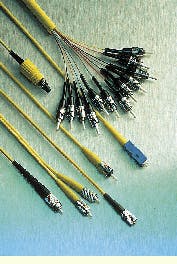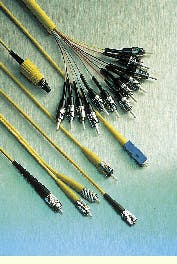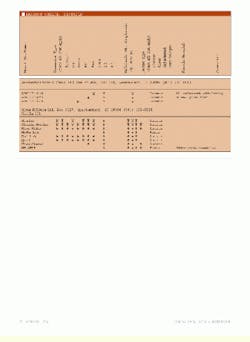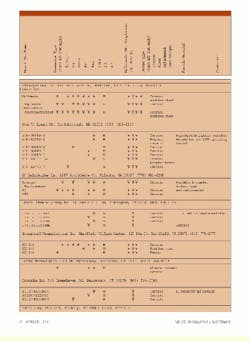Gail Leach Carvelli
In any fiber-optic cable installation, the way the cables are attached to the system--whether at a building entrance, in a wiring closet or at points between the transmitter and the receiver--is vital to the success of the telecommunications network. If done well, this connection allows optical signals to pass with low attenuation and little return loss. One of the proven ways to join optical fibers is with a fiber pigtail--a fiber cable with a factory-installed connector on one end and unterminated fiber on the other (see Product Update table beginning on page 16).
Component considerations
Pigtails bridge a critical junction in the fiber-optic network, so installers need to choose products made with reliable components. Because they are basically cable assemblies, pigtails use many of the same parts that experienced fiber-optic technicians are already familiar with--a connector, a ferrule, standard fiber and jacket types, including singlemode and multimode varieties.
While each of these components is important, Rudolph Montgelas, senior fiber optics product manager for Hubbell Premise Wiring Inc., says one stands out. "An important element," he says, "is the quality of the connector itself. You need to know certain characteristics, such as insertion loss, the type of polish used and how well [the connector] is terminated to the cable."
Casey Whitelaw, sales engineer for Siemens Fiber Optics, agrees. "Even with standards, there is significant variance between connector styles and manufacturers," he says. "You have to use fiber and connector types that meet a particular application`s needs." Selecting the proper product depends on job specifications.
Ferrule material, whether zirconia ceramic, plastic or stainless steel, must also be specified when ordering a pigtail. Whitelaw says Siemens relies on ceramic ferrules for its assemblies. "When it comes to other ferrule material, the cost/performance trade-off isn`t tolerable for our customers," he states. "If you go with a metal ferrule, it is a waste for any singlemode application, especially if you need Bellcore compliance."
The manufacturer of the optical fiber should also be taken into account, says Bob Powers, fiber-optic group manager for Frontline Network Support Systems Inc. (Northborough, MA). "The main concern is that the same glass be used in the pigtail and in the fiber cable," he says. "We tend to use Corning and AT&T [fiber]."
The length of the pigtail`s cable is another element that must be specified. Larry Sellers, a trainer in 3M`s fiber optics division, suggests ordering a few feet more than you think you`ll need. "That extra slack allows for splicing errors to be corrected," he says. "Without it, you may have to start with another pigtail."
Pigtails, which some say resemble the tail of their namesake, are attached to cables by fusion or mechanical splicing, both of which provide a fast termination method, according to Larry Johnson, president of The Light Brigade Inc. (Kent, WA).
Lower labor costs
"Ninety-nine percent of singlemode applications use pigtails," he says, adding that pigtails are also used in many multimode applications. "One of the benefits [of pigtail use] is lower labor costs," Johnson notes. Installers working with singlemode fiber typically have access to a fusion splicer--an expensive piece of equipment that costs $6000 to $30,000 or more. "With a fusion splicer you just splice the pigtail right onto the cable in a minute or less," he adds.
However, Johnson points out that a fusion splice must be covered by splice protection and housed in a splice holder or tray. While these extra items offset some of the labor cost savings, they provide a higher level of protection.
Testing a pigtail in the field is not easy. The unterminated end is difficult to check until the pigtail is actually spliced to the equipment. Because of this, Johnson insists that installers rely on the manufacturer and its testing claims. "The factory that makes the pigtail is guaranteeing [low] reflection and [high] quality--at a good price," says Johnson, noting that pigtails cost $10 to $50 each.
Quality is typically high because the connectorized end is attached in a controlled environment--the factory. "The factory can make singlemode pigtails more accurately than a field termination can be done," Johnson maintains. "In the field, you are dealing with unknowns, but in the factory, you are dealing with credible measurements."
Bill Rowe, president of Integrated Communications, says every pigtail he uses in the field has to be tested at the factory and labeled with insertion and return loss. Also, a serial number, affixed to the pigtail, provides traceability to the factory measurements. "This procedure helps protect the contractor," he says.
Some installers dodge the potential problems by avoiding pigtails altogether. Instead, says 3M`s Sellers, they buy unjacketed jumper cables. "Because there is a connector at each end, the installer can test the jumper and verify how it works," he says. "The unjacketed jumper can then be cut in half and used as two pigtails."
With connectorized fiber on one end, pigtails can be constructed with nearly any connector. The other end remains unterminated, allowing it to be spliced into a fiber-optic network.




